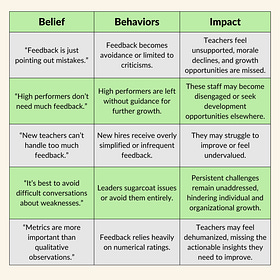Belief Inventory Research Guide
What does the research and evidence tell us about feedback? How does this influence our beliefs?
In the last post, I gave you a belief inventory for feedback because we know that beliefs drive action.
Your beliefs about feedback are limiting your impact
·
Feedback is one of the most powerful tools for improving organizational performance, engagement, and innovation. Yet, misconceptions and limiting beliefs about feedback can prevent leaders from maximizing their potential.
If you haven’t written it down, I’ll give you the time now to do that. Go ahead. I’ll wait.
1 = Strongly Disagree, 2 = Disagree, 3 = Neutral, 4 = Agree, 5 = Strongly Agree
Regular, meaningful feedback directly influences the motivation and performance o…
Keep reading with a 7-day free trial
Subscribe to EduCoach by Jo Lein to keep reading this post and get 7 days of free access to the full post archives.




